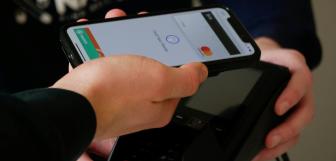NFC Payment - Discover All About Near Field Communication
From sending emails to personal banking to apps, we’re using our mobile devices more and more to help us manage our everyday lives.
So, it should come as no surprise that NFC payments— paying for stuff on your smartphone (or tablets and wearables) — are picking up steam. It's very likely that you're going to be seeing a lot more of your customers wanting to make contactless payments on their phones.
To prep you for this, we've created a handy little guide to teach you everything you need to know about NFC payments. From what they are, to how to accept NFC mobile payments at your retail or hospitality business. Let's get it to, shall we?
What is NFC?
NFC (short for near-field communication, FYI) is the technology that lets two NFC-enabled devices — like a customers' phones and card machines — ‘talk’ to each other when they’re close together. “Talking” here means the wireless exchange of information between the two NFC enabled devices when they’re very close together.
NFC can be used for sharing media between smartphones, event or building access, interactive toys, or, you guessed it, making and taking contactless payments! The most popular NFC mobile payment apps currently are Apple Pay, Android Pay, and Samsung Pay.
Difference between EMV and NFC transactions
Now, you might have heard EMV and NFC lumped together in talks. That’s because they're both new-ish, secure, authenticated payments. They're also both encrypted to protect against things like counterfeiting. However, EMV and NFC aren't the same. Here's how they differ:
differ:
NFC stands for near-field communication. It uses short-range wireless communication for contactless transactions. NFC technology is what makes mobile contactless payments like Apple Pay or Google Pay work. It offers a quick tap-and-go experience, which is great for small, everyday purchases.
EMV stands for Europay, MasterCard, and Visa. It uses microchip technology for secure, contact-based transactions. It requires physical insertion of the card and usually a PIN or signature. EMV is the technology behind chip card payments, created by big names like American Express, Discover, JCB, Mastercard, UnionPay, and Visa.
What was used before NFC and EMV? Well, the US has seen a big trend shift, switching from magnetic stripe cards to more secure chip cards. These chip cards are doing wonders in stopping counterfeiting and they're a big hit.
If you’re running a business, it’s a good idea to get a POS terminal that can handle both EMV and NFC payments so you’re ready for all the latest, secure payment methods your customers want to use. But remember, EMV payments need to be inserted, rather than swiped, and NFC is tap-and-go.
TIP
Check out our complete payment methods guide to better understand the different types out there.
How do NFC payments work?
Near-field communication (NFC) lets two devices talk to each other wirelessly when they're close together.
NFC is a type of RFID (radio-frequency identification), which uses radio waves to identify objects. RFID has been around for a long time and is used in things like grocery store scanners, baggage tags, and cattle tags.
Introduced in the early 2000s, NFC uses a specific RFID frequency (13.56MHz) for short-range communication. It’s commonly used in ID cards for building access and is increasingly popular for contactless payments.
If you've shopped at places like Whole Foods, Walgreens, or Office Depot, you’ve likely seen contactless payments in action. NFC mobile payments work because they don’t require physical contact between a smartphone and a payment terminal. Instead, people just hold up their mobile devices to a NFC-enabled reader to make a contactless payment.
What about Wi-Fi?
To be clear: you don’t need Wi-Fi for the contactless payment itself, but you do need internet connectivity at some point for authorization and payment processing. Here’s how it works:
- When you tap your NFC-enabled credit card or smartphone on a terminal (or card reader), the NFC communicates securely between the card/phone and the terminal. This bit doesn’t need Wi-Fi but uses those short-range radio waves.
- Next, the payment terminal reads the information from the card or phone and makes a transaction request.
- Now, the payment terminal connects to the internet (Wi-Fi, Ethernet, or cellular data) to authorise and complete the transaction with the payment processor or bank. Some payment terminals can operate in offline mode though. This means the transaction data is temporarily stored and processed once an internet connection is re-established.
SIDE NOTE
If you’re using smartphone payments, such as a mobile wallet app like Apple Pay, the NFC still doesn’t need Wi-Fi. But your phone might need an internet connection for certain functions, like verifying your identity or updating your account balance after the transaction
Why should I accept NFC payments?
NFC-enabled payments have been referred to as "the future of payment technology" with increasing frequency. And it’s definitely here to stay now! Here's why:
🔒They're secure
Mobile wallets like Apple Pay make your bank details super secure by "tokenizing" them. This means your info gets scrambled into a code that's useless to fraudsters. Plus, this code changes with every transaction, making it nearly impossible to steal.
NFC payments like Apple Pay are also protected by fingerprint and facial recognition on your iPhone. To use Apple Pay, you need Touch ID or Face ID, which fraudsters can’t fake easily.
⚡Faster
Everyone’s getting EMV chip cards because they’re more secure than the old magnetic-stripe cards.
But EMV transactions are actually pretty slow. The chip and pin and the processor have to communicate to make sure everything is okay, which takes time.
NFC digital payment methods are way faster—transactions between two NFC devices take just seconds. As people realize how slow chip card payments are, they’ll likely switch to mobile payments since they're just as secure and accepting NFC payments is easier. This trend has already happened in other countries where EMV is the standard.
📱More convenient
We’re used to doing everything on our phones, and many people feel lost without them.
With smartphones always handy, NFC-enabled contactless payments are the most convenient way to pay for your customers.
No more digging for wallets or handling cash.
Approaching potential concerns when using NFC mobile payments
Using NFC mobile payments is great, but there are some downsides to be aware of:
- Security risks: While NFC payments are generally secure, there's always a risk of data breaches or unauthorized access if someone’s phone is lost or stolen. As a business owner, you need to make sure your NFC systems are compliant with security standards (such as PCI-DSS) to protect against data breaches.
- Technical issues: Sometimes, NFC payments can fail due to technical glitches or connectivity problems. In such cases, having a backup payment terminal is handy to avoid frustrated customers.
- Cost of implementation: Your business may need to invest in new NFC-enabled payment terminals or upgrade your current POS system if your old tech isn’t NFC compatible. This can come with a cost.
- Ongoing costs: There may also be additional fees for maintaining and servicing NFC equipment.
- Is cash still king?: There are plenty of customers who still prefer cash, chip-and-pin, or don’t know how to use NFC payments. So while you may invest in NFC-enabled payment devices…you might still need that cash drawer handy (or a lot of patience in educating customers on how to use NFC).
- Staff training: Your team might need to be trained on using any new payment systems effectively. (Although, we’d argue that all good payment device suppliers should give you training and support!)
Payment processing services made simple
Take integrated payments at one fixed rate, with no hidden fees - anywhere, any time.
How to accept NFC payments with Epos Now’s terminals
You’ll need an NFC-enabled card reader or payment terminal to accept NFC mobile payments at your business. With Epos Now’s retail POS solution or hospitality POS system, you'll be set up for seamless payment processing of all types of contactless payments. Here’s how it works:
- Setup: Get an NFC-enabled card reader or payment terminal compatible with Epos Now’s system.
- Versatile payments: Customers can use contactless debit cards, credit cards or their digital wallet apps to complete the transaction.
- Tap to pay: Your customers can simply tap to pay on the card reader (AKA make a contactless payment) using their smartphones. Epos Now's POS system will process these NFC transactions smoothly.
Plus, if in-person payments aren’t possible, Epos Now Payments offers a "Pay by Link" feature. This lets your customers pay securely online, ensuring you never miss a sale.
Want to learn more about payment processing? Check out our 'what are payment processing solutions' today.
FAQ about NFC payments
- Is a NFC payment safe?
-
Yes, NFC payments are very safe! They’re used around the world by numerous businesses. They use a process called tokenization, which scrambles your bank info into a code that's useless to hackers. Plus, you need to use fingerprint or facial recognition to approve the payment, adding an extra layer of security. So, your money stays protected.
- How can merchants implement NFC mobile payments?
-
Merchants can start accepting NFC payments by getting an NFC-enabled payment device. These terminals can handle both EMV chip cards and NFC transactions. Just set it up, and you’re ready to accept quick and secure mobile payments from customers.
- What is an example of a NFC mobile payment?
-
A common example of an NFC mobile payment is using Apple Pay at a store. You simply hold your iPhone or Apple Watch near the NFC enabled device, authenticate with Face ID or Touch ID, and the transaction is done in seconds. It’s fast, easy, and secure.
- Are there any charges for NFC payments?
-
Usually, there are no extra charges for NFC payments. They typically have the same processing fees as other card transactions. Always check with your payment processor for specific details, but NFC payments generally don’t add any extra costs for merchants or customers.




